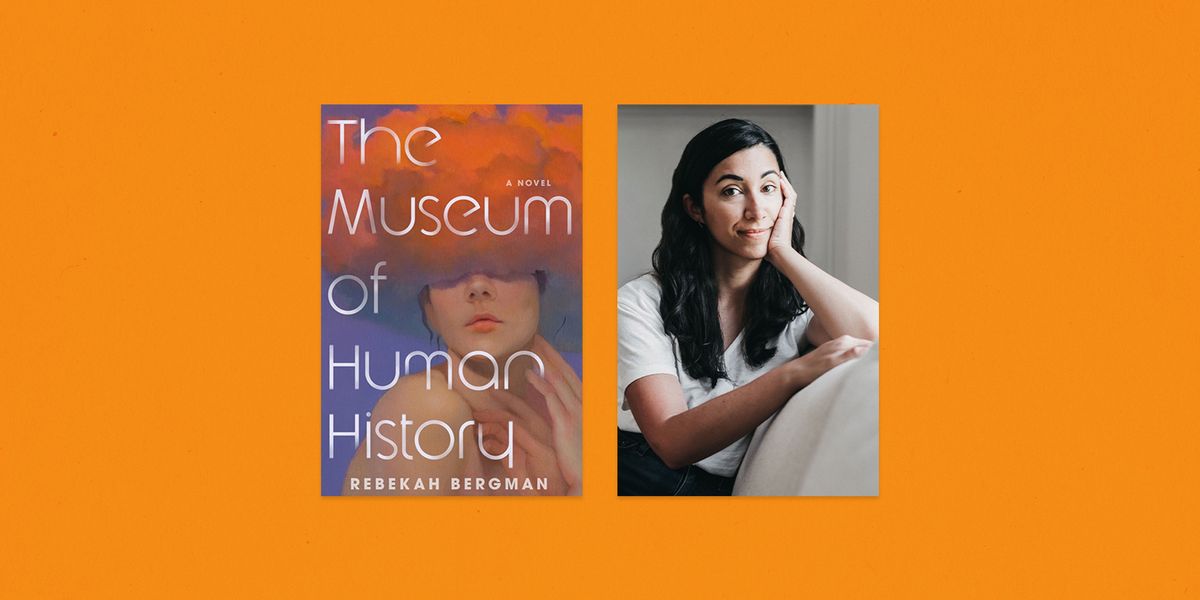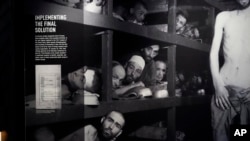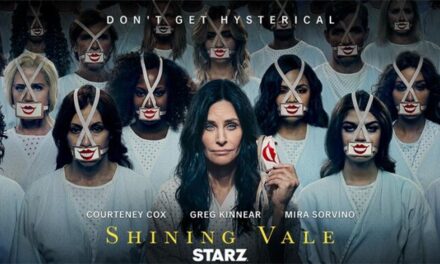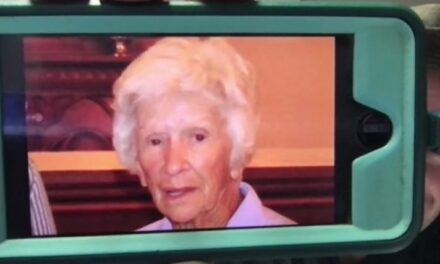
Sometimes a novel lures you into its narrative arc by appealing to your curiosity, taking you on an adventure somewhere just out of the periphery of your imagination. Such is the case with Rebekah Bergman’s debut novel, The Museum of Human History (which comes out on August 1), a tome that carefully considers the existential question of time and our relentless pursuit of more of it because we never, ever feel like we have enough.
It is a work of literary fiction infused with sharp cultural commentary that follows the trajectory of those surrounding a young girl called Maeve who, due to a tragic pool accident, becomes frozen in time and an unwitting object of worship. The peripheral characters surrounding Maeve all wrangle with the questions of fate and time when the biotech company that Maeve’s late mom worked for introduces a procedure that promises to keep people from aging and feeling pain until they die.
During an interview with Shondaland, Bergman appears against a large wall of bookshelves stuffed with books that are artfully arranged by color, further illustrating how she wanted to write all her life and read obsessively as a little kid. “It’s the first thing I ever remember wanting to be, other than when I was really little, when I wanted to be a waitress on roller skates,” she says. “It’s sort of been the dream for a very, very long time.”
Her various accomplishments prove her studious devotion to her craft. The Swampscott, Massachusetts, native studied creative writing at Brown University, taught, then left teaching to earn her master of fine arts from the New School. She published numerous short stories (her once-preferred medium) in literary journals such as Tin House Online and Joyland and has a gig as a contributing editor of Noon. She was a 2018 Tennessee Williams Scholar at the Sewanee Writers’ Conference and a winner of The Masters Review Anthology Prize, judged by Rebecca Makkai, and has earned fellowships, grants, and residencies and a 2020 Pushcart Prize nomination.
Impressive literary accolades aside, Bergman’s love of what she does seems to exude from her smile during a discussion of what inspired her book, how she went about writing it, and who inspires her in general.
VIVIAN MANNING-SCHAFFEL: Every book begins with a spark, that initial moment you get an idea that becomes the book. What was that moment for you?
REBEKAH BERGMAN: It’s funny to think back on it because in some ways, there wasn’t actually just one spark — it was a book that I kind of wrote my way into, so I didn’t necessarily know what the project was going to be until I was significantly far along in it. I think one of the things that was in the back of my brain for years was the story of this girl in the town where I grew up. She’d fallen into a coma after an accident and was said to perform miracles — this all happened a few blocks away from where I lived. I was very young, and I really didn’t know what was going on, but I would hear about it a lot. I didn’t think about it for years, and then as an adult, I was struck by the strangeness of that story and what went on around this little girl. I think I inadvertently kind of wrote my way back into that story a little bit.
VMS: People seem to view Maeve with this holy aspect, I think. You included this quote from “Little Briar Rose” — a Brothers Grimm quote about sleep — in the intro. Did that spark something too? How did you land there?
RB: That’s one of the things I kind of wrote my way toward, I think. I didn’t set out to write a futuristic fairy tale, but at some point, I realized that’s what I was doing. A character who sleeps for so, so long just kind of naturally recalls the story of Sleeping Beauty. The first draft was meant to be linked stories where I thought that’s what it was; then I realized these stories were quite linked and braided together. Then it became a novel and stories, and every revision brought things tighter and tighter together. The story of Briar Rose ended up being a structure that I was leaning on toward how might this all wrap together as a single arc.
VMS: The book reads like a series of short stories that are dispersed throughout the narrative. You have all these characters and their stories that evolve around Maeve’s sleep. Did you start the book as a short story?
RB: Well, yes and no. I’d only ever written short stories, sometimes longer short stories, but I only ever tried to write short stories before attempting my first novel. The first take I made to write a novel was much more closely inspired by the true story about the girl in the coma I was telling you about. I had to abandon it. Setting out to write a novel was not a productive exercise for me! The very next thing after abandoning my novel was the first short story in what I thought [were] linked short stories, and I kind of tricked myself into writing a novel again. The first piece of anything I wrote for this book was a short story.
VMS: Where did you start?
RB: I started pretty far along with Syl and Abe. I didn’t think that I was going to get anywhere near the girl and the sleep. At that point, I was really attracted to the idea of this futuristic technology that could stop your body from the physical signs of aging and how that would play out on an interpersonal level with this family, where age is a big factor in their family dynamic. If one of them wanted to have this procedure and the other one didn’t, what would that look like? That was the gateway to the rest.
VMS: You integrate chronic pain into the scenario too. It’s interesting how you decided to take pain and aging away in tandem. How did that concept evolve?
RB: Pain and age and memory … were these three prongs that everything was sort of circulating around. They all came to be sort of similar, in some respects; the pain of memory and the pain of time, and time itself bringing pain. I don’t know when I chose to have the procedure eliminate both, but it felt right that it would, that something would stop the appearance of time on your body but also would stop the experience of chronic pain within your body.
VMS: Sometimes these things are subconscious too — all three could be braided infinitely, really. There’s the whole biotech aspect of it and how we’re always trying to hack youth and eternal life and look and feel young forever, even though aging is an inevitability. I was trying to think of the prevailing theme. You play with time in the structure of the book — both the bastardization of time and how the time humans get to spend together, in some cases, is never enough. How did you land on that concept?
RB: Time is never enough, and everything else sort of sparks up because of that. What can we make with the time we have? How will the time that we did have look in retrospect? That was a question that a lot of the characters are sort of anxious about — especially Luke and Tess. The time you have with someone can seem so small in the span of a life, and for generations, and the sadness and the beauty of that — that something so small can be so meaningful. I entered into the world of geology while writing this; the history of Earth is so enormous, and any one individual human life is so small next to that. I was just very struck by that for a long time, as are many of my characters.
VMS: Your study of it was extensive — you must’ve fallen down many rabbit holes! How much research did you have to do in terms of geology?
RB: Probably a lot, but I don’t think I was thinking of it as research at the time. That’s the beauty of a first book — all the things that interested me, I was able to find a way to have them serve the purpose of researching the novel. I did a lot of research on quite a lot of different topics: geology, tectonic plates, and ancient human life.
VMS: How long did the book take you to write?
RB: I started it eight years ago. The first draft took five years. I spent the early part of the pandemic locked in my apartment trying to finish the first draft. Then, it was two years of reworking it after that first draft was done.
VMS: You seem to be more of a channeler than someone who outlines.
RB: Yeah, I think I was. I think that proved fruitful in a lot of ways. That first attempt I was talking about, I sort of thought I knew too much, and that did not serve me. With this, I had to let it take me where it was going to go. It created a lot of challenges to do it that way, and I hope to not do it that way again. A little bit of an outline is helpful, but I think because I told this book through so many different voices, I kind of needed to channel those voices and figure out who these people are and how do they connect back to everything else, writing my way into that.
VMS: Did you toggle back and forth between the voices, or did you write each voice in its entirety and edit them in?
RB: For the most part, I wrote them each as stand-alone, and then there was all of the editing and revising. Recalibrating something for someone would just ripple through so many other different plotlines and places, especially time changes. The best moments were the moments where I figured out something that I didn’t know because I didn’t have a plotline of how people were going to fit together. Those were also some of the worst moments because then I was like, “Oh, no! I have to redo [it]!”
VMS: Are the settings fictional?
RB: They’re fictional. Something I was consciously trying to do with the book is make everything a shade different from our own world. I wanted it to be believable but also not like any one place in particular, so it’s an amalgamation of a couple of different places, and it’s also an imagined fiction in a lot of different ways.
VMS: What led to the whole Genesix commentary and the nefarious role that biotech plays in preying on our desire for infinite youth?
RB: I tried to draw from the world we’re living in to create a believable alternate present to where we are today. It’s biotech in the book, but it’s also just big pharma and certainly the connections to the end of pain or ways to stop pain. I was looking a lot into the history of the opioid addiction and epidemic and the role that big corporations played in playing into that very real and very understandable desire to end something that is a horrible experience. But then there are all the side effects, both physical and societal, when you do try and make a profit off of something like that.
VMS: And push it to market before you’ve done your due diligence. I love how you made Luke a pharma ad guy. How did you land on that?
RB: I had Luke and his relationship with Tess before I had their careers, which is important for their characterization. He works in advertising and doesn’t always stand behind the work he has to do; she’s a humanitarian. There’s the line about how, in a post-capitalist world, only one person can afford to do something good. I think that’s true, sadly. The whole idea of biotech in the book, and all these different technologies to end pain are profitable and are making such progress because they are playing into this innate human desire people have to stay young, stop pain, and stop time. I think advertising is interesting in that way: How do you connect with a market and be clear about one longing you’re fulfilling? There’s a true need there — not one that should necessarily be fulfilled — but that longing is there. The marketing story of the procedure in the book is a plotline and ties in to the cover.
VMS: The book also digs into loss and letting go, which are part and parcel of the inevitabilities of time.
RB: It’s a lot about fighting against the small amount of time that we have. People in the book and in life, often there’s this desire to fight against it, even though there’s no fighting it ultimately. Then, there is acceptance and a sadness to accepting that, but I also think there’s also a beauty to it. Not everybody in the book gets the full arc and comes to a place of acceptance, but a few people do, and their arcs feel the most full and beautiful to me.
VMS: Who did you read who made you realize you wanted to write?
RB: The first book that I read and cried over was Little Women. The characters in that book are so well drawn and so real. Each of them is a person I feel like I knew as a child. That led me to all of Louisa May Alcott’s other books. [And Madeleine L’Engle’s] A Wrinkle in Time; I had a period of time of being very into fantasy.
VMS: It was only natural for you to want to create a world as well.
RB: On the flip side of that, all of the Sharon Creech books, which were extremely realistic and were all about the angst of growing up. In college, I think it was all about short story writers. … That’s when I read a lot of Amy Hempel, Alice Munro, Grace Paley, short story masters like that.
VMS: Who are some of your favorite writers today?
RB: I try to read a lot of contemporary fiction, and I love a lot of what I read, so I feel a lot of recency bias, but I just finished Elizabeth McCracken’s The Hero of This Book, which is a very slim auto-fictional novel. It just blew my mind and reminded me of what a book can do. In short story territory, Bliss Montage by Ling Ma is one that I read a bit ago, and the feeling of reading it stuck with me. Jenny Offill is another favorite. When I read to feel inspired to write, I go to masterful sentence writers. I went to Station Eleven by Emily St. John Mandel. That helped me figure out how to wrangle different pieces toward a whole. She’s so good at that.
VMS: What do you hope people will think and feel about their own lives when they put The Museum of Human History down?
RB: I find the books that leave the biggest mark on me leave me with a feeling. After going on this journey with characters who are fighting against this inevitability but then come to see the beauty that it has and stop fighting against it, I hope that holds meaning to people and is the feeling they have when they see the book on their shelf.
Vivian Manning-Schaffel is a multifaceted storyteller whose work has been featured in The Cut, NBC News Better, Time Out New York, Medium, and The Week. Follow her on Twitter @soapboxdirty.
Get Shondaland directly in your inbox: SUBSCRIBE TODAY




